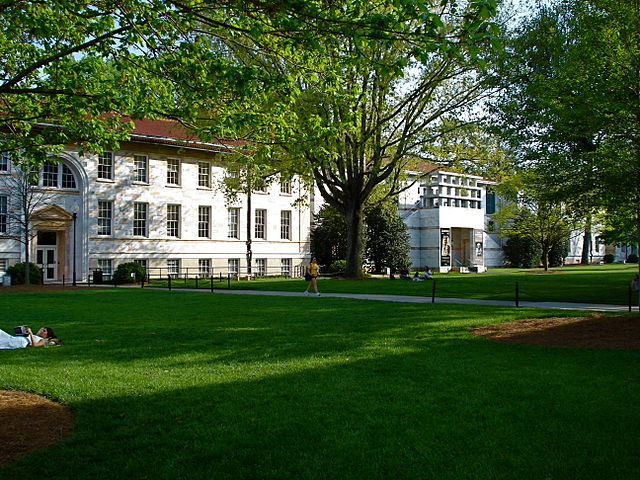
Wikimedia Commons/Public Domain
Late into the eve of fall break, my fellow Complex residents and I were greeted by dirt-brown water in our showers, sinks and bottle refillers. Instead of a warm shower or a glass of water to cleanse the fatigue of travel, we had to brave the cold autumn night to shower at the Woodruff Physical Education Center (WoodPEC) and dig through our wallets to buy water from the Eagle Emporium.
Emory University mishandled the water discoloration crisis due to a lack of communication and backup resource protocols, crippling student trust in the school and exposing the unpreparedness of the administrative departments.
It was a horrid night, sieged by the uncertainty of whether we would run out of drinking water while grinding on unfinished assignments due the next morning. There were no notifications by the University of the water discoloration, except by the Resident Advisors (RA) and Sophomore Advisors (SA)who advised residents to stay away from the water. These warnings, however, came far too late, and soon problems began. Some residents began to decry stomach pains or coughing fits. I myself experienced a sore throat, feeling it clogging up like a squeezed toothpaste tube. We hoped that aid or help would arrive from Emory University facilities, and prayed that emergency maintenance would show up to save the day. Some of us would’ve made do with even a single bottle of water. Even in the GroupMe chat, some folks stated that they would’ve been satisfied if Emory had even gracefully donated a bucket to collect rainwater. Help did not come.
The following day came and went. Many of us got used to the conditions, yet Emory’s administration still did nothing. On the morning of Oct. 12, in a fit of frustration, I emailed President Gregory Fenves and complained about the negligence we felt – abandoned by Emory in our time of need – and the erosion of trust that would stem from this occurrence. As the face of Emory, the very least President Fenves could have done is to inform us of the ongoing problem. One quick email or a LiveSafe notification would have sufficed. I even would’ve been satiated by a carrier pigeon.
Instead, what should have been the jobs of full-time employees fell on full-time student advisors. In Harris Hall, advisors warned students about the dangers of the water. Being the most visible authority, they faced immediate scrutiny. Had the situation been more dire, the underpaid student advisors would have been the target of fear-filled panic.
Approximately three hours after my email to President Fenves, the first official communication from the school was dispatched to us students on October 12th. The email warned us students to not drink or use the water until further notice. It would have sufficed if this was a temporary issue, but the issue began way before the 12th, basically occurring during fall break, and no warning nor steps were taken to curtail the effects of it. I wanted to know why.
I sent an inquiry on the 16th of October to Assistant Vice President of University Communications and Marketing Laura Diamond, receiving a response two days later explaining why the water was discolored. Specifically, the water was the result of Dekalb watershed flushing and that at no point was it unsafe. Even if the water was never unsafe to consume, it wasn’t fully safe to use either. The reports of stomach pains, sore throats, coughing fits, and rashes from the use of these sediment-colored waters still were problems that affected the student body. We were not informed beforehand and there were no easily accessible alternatives for us. What if it was worse? What if the water turned out to be hazardous? Emory, the effort was too little too late.
Emory needs to better develop its protocols and resource allocations for emergencies. First, Emory’s housing facilities and operations department should apologize to those affected by the water discoloration. The incident has enshrouded students and parents alike with doubt about Emory’s preparedness to deal with non-typical emergencies. Second, the University must establish a system of using LiveSafe or email or one of the hundreds of available means of communication to inform residents of ongoing developments before they become problems. Third and most importantly, offer alternatives like giving out bottles of water to residents or opening up nearby Emory facilities to aid in providing service and goods. The problem with one minor issue being neglected is that it enables a slippery slope of incompetence. If we disregard the issue this time because no critical health issues were directly inflicted, then it creates a false sense of security where any crisis is going to be treated similarly, including potentially fatal ones.
Emory should be better than this, and constructive criticism is necessary to ensure no such occurrence happens again. But a thought persists in my mind: in an emergency, would Emory even have enough body bags? Prevention is always better than the cure, every crisis should be treated as seriously as the most severe. After all, for discoloration or crises, they only have to be lucky once, we as people have to be lucky every time.
Frederic ‘Freddy’ Xiong (25C) is from Fremont, California.
Correction 11/3/2022 4:49p.m.: Previously this article referred to the water as being “contaminated” in its headline and in three other places in the article. However, the water was safe to use and drink, so the correct term would be “discolored.”
Freddy is from Fremont, California. He’s majoring in business administration and planning to attend the B-school. He’s involved with the debate team and works at both the admission office and student center. He also believes Shrek 4ever after is the magnum opus of the century




